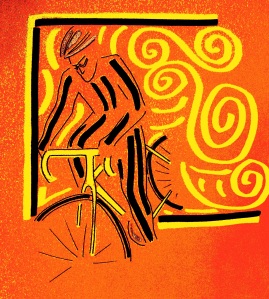If you compare length for length, then over 60 per cent of Race Across America (RAAM) is uncharted experience for riders from India.
RAAM is a little over 3000 miles (approximately 4800 kilometers) long.
The longest Indian ultra-cycling event serving as qualifier for RAAM is Ultra Spice, which spans 1750 kilometers (1087 miles); the race proceeds from Goa to Coorg, Wayanad and Ooty and then returns to finish in Goa. The 1750 kilometers length of this race means that somewhere past the first one third of RAAM’s 3000 miles in the US; Indian riders begin to tackle unfamiliar waters. Will having a race longer than Ultra Spice on the domestic circuit help shrink that element of unknown at RAAM and similar races elsewhere?
“ Yes obviously,’’ Divya Tate of Inspire India, organizers of Ultra Spice said, adding, “ just as doing RAAM once or even failing at it, makes it easier to do it next time! But seriously, training approaches worldwide don’t demand for you to do the distance while you train, especially not for ultra-cycling.’’ Having qualified for RAAM and trained for it diligently, Lt Col Bharat Pannu was supposed to participate in the 2019 edition of the race. But an unfortunate injury sustained in rides ahead of race in the US, forced him to withdraw. Asked whether he thought having a race longer than Ultra Spice in the domestic circuit would help reduce the unknown in RAAM, Bharat said, “ as per my experience, the distance of 1750 kilometers provides you with all necessary experience required for RAAM, except the distance. And for distance such as RAAM, it becomes a test of your mental strength and your ability to endure pain. Definitely, a longer race will prove to be beneficial,’’ he said.
According to Divya, Ultra Spice is the bridge between the minimum RAAM qualifiers of 640 kilometers and RAAM itself. “ One doesn’t need to participate in longer ultra-races to train for RAAM. Crewing or doing team at RAAM would however be highly recommended before attempting solo. Also with four RAAM qualifiers being offered in India, a lead-up to RAAM solo or team should include as many of these, offering a variety of terrain and challenges, which is why these were created.,’’ she said.
If a longer race is to be created in India, what will be the challenges?
“ The biggest challenges are monitoring, funding and the participation numbers. Inspire India does have two ultra-races that have been in the pipeline for 3-4 years that we can only now consider putting up since we have affordable tracking devices in India. Funding these big races is not yet happening and they are really hard to run. The longer the race, the lower the number of people able to or interested in participating, and these races are expensive to participate with support vehicles etc. Which is why the two races – The Great Coast Race and The K2K Ultra will have a different format, closer to bike-pack racing. The expense of participation is also why we have now created a separate category in Ultra Spice 1750, which is unsupported or without personal support vehicles. But the unsupported category is not a RAAM qualifier,’’ Divya said.
In 2017, Amit Samarth had become the second Indian to complete RAAM solo and the first to finish it in his first attempt. In 2018, he had successfully completed the Red Bull Trans-Siberian Extreme; a 15-stage, 9100 kilometer-long race in Russia. He had a very simple matrix as reply for the question this blog posed on whether a race longer than Ultra Spice in India, would help Indians tackle RAAM better. According to him: longer the race, longer the recovery. “ You can do a race that is longer than Ultra Spice to reduce that element you call the unknown in RAAM. But it should be done at least 5-6 months before RAAM,’’ Amit said. He suspects Indian cyclists may be over-training for RAAM. That is what happened to him in 2017. Not knowing what to expect, he trained rigorously and ended up feeling tired during the actual race in the US. “ What we don’t realize is that in India, we do too many races. It makes us mentally surer of the distance but eventually it also makes us physically slower,’’ he said of the folly in overlooking rest and recovery. Amit thinks cyclists like Christoph Strasser (2019 marked his sixth victory at RAAM solo) don’t exhaust themselves doing very long rides in training.
Strasser at RAAM is a treat to watch on the race’s live tracker. RAAM solo and RAW solo (Race Across West; a smaller race within RAAM) start on the same day. Those riding as multi member-teams start later. In 2019, Strasser steadily pulled ahead of the field, hung in there and finished first. The gap between him and second placed soloist was palpable. In that gap, a few teams raced in (because they cycle in relay format, they cover ground faster) to cross the finish line. It was after this early flurry of team finishes that the rest of the solo racers started completing the race. Simply put – keeping aside other issues like sleep management and experienced crew, Strasser rides faster than others. His average speed at 2019 RAAM over the eight days, six hours, 16 minutes he took to reach the finish line, was 15.48 miles per hour. The fastest team this year at RAAM was the 4-person Team Alpha from Austria; riding in relay format they covered the course in five days, 15 hours, 33 minutes at an average speed of 22.65 miles per hour.
After RAAM 2017, when Amit decided to head for Trans-Siberian Extreme, he knew two things – the race in Russia at 9100 kilometers is significantly longer than RAAM; he didn’t want to repeat what happened to him at RAAM 2017. He connected with Pierre Bischoff of Germany – Bischoff is a much experienced ultra-cyclist; 2016 winner of RAAM – to learn how best to prepare. Bischoff’s suggestion was to focus on two aspects – speed and recovery. “ I made sure I did not over-train for Trans-Siberian Express,’’ Amit said. He became the first Indian to complete Trans-Siberian Extreme; Bischoff won it.
So if needlessly piling on miles in training is unwise, how then do you tackle the unknown in RAAM?
“ There is no other way but to deal with it mentally. One thing you must understand about ultra-cycling is that because the distances involved are huge, you cannot cover all aspects in training as you would for a marathon. There will always be the unknown,’’ Amit said.
(The author, Shyam G Menon, is a freelance journalist based in Mumbai.)


